The Red Goshawk (Erythrotriorchis radiatus) stands as a captivating emblem of avian prowess, enchanting bird enthusiasts with its distinctive features and elusive demeanor.
Endemic to Australia, New Guinea, and nearby islands, this medium-sized raptor belongs to the Accipitridae family, showcasing remarkable adaptations to dense forest habitats.
Named for its vibrant chestnut-red plumage, the Red Goshawk presents a striking contrast against the verdant canopies it inhabits.
Its hooked beak and talons affirm its status as a skilled predator, preying upon small to medium-sized mammals, birds, and insects.
Recognized for its monogamous breeding pairs, intricate courtship displays, and cooperative parental efforts, the Red Goshawk’s nesting behaviors unveil a complex tapestry of avian life.
However, facing threats from habitat loss and human activities, the conservation of this species becomes paramount, urging a deeper understanding and commitment to preserving the magnificence of the Red Goshawk in the wild. Stay focused.
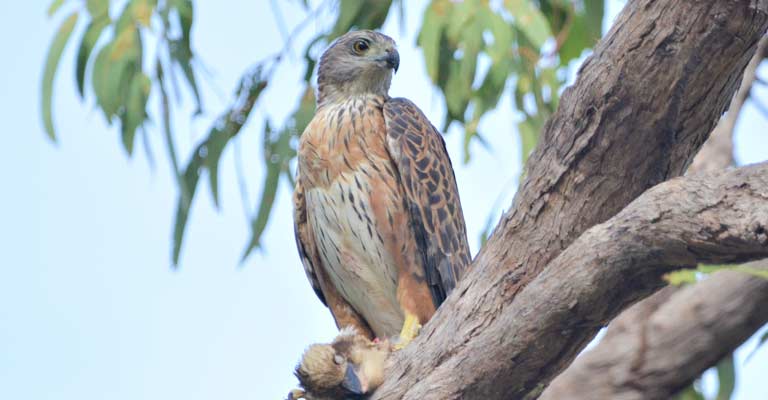
Physical Characteristics of Red Goshawk
The Red Goshawk (Erythrotriorchis radiatus) is a striking and elusive bird of prey native to Australia, New Guinea, and nearby islands.
Identifying this specific bird requires careful observation of its physical characteristics, behavior, and habitat.
Here are eight key points to help in the identification of the Red Goshawk:
Size and Shape
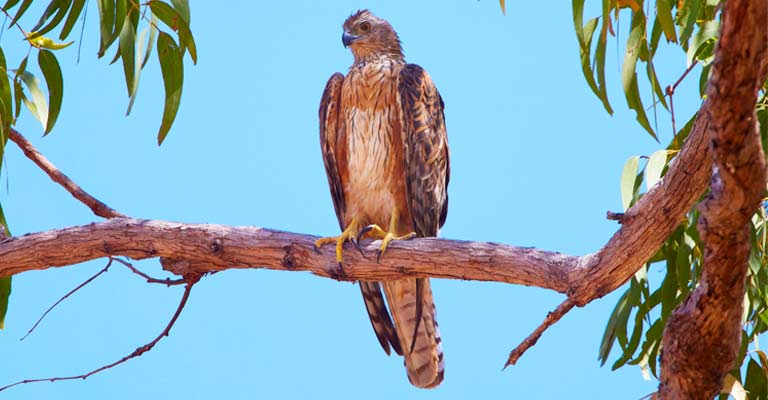
The Red Goshawk is a medium-sized raptor with a distinctive shape. It has a compact and robust build, characterized by a broad wingspan and a relatively short tail.
Adult males typically measure around 38-46 centimeters in length, while females are slightly larger, ranging from 46-55 centimeters.
Coloration
One of the most striking features of the Red Goshawk is its vibrant coloration. Adult birds exhibit a rich chestnut-red plumage on their upperparts, giving them their name.
The underparts are generally white with fine reddish-brown barring, creating a visually striking contrast. Juveniles, on the other hand, display a more subdued brown color until they reach maturity.
Head and Facial Features
The head of the Red Goshawk is marked by a distinct, pale face, contrasting with a darker crown.
The eyes are large and yellow, and the hooked beak is dark and strongly curved, typical of raptors adapted for tearing flesh.
Flight Pattern
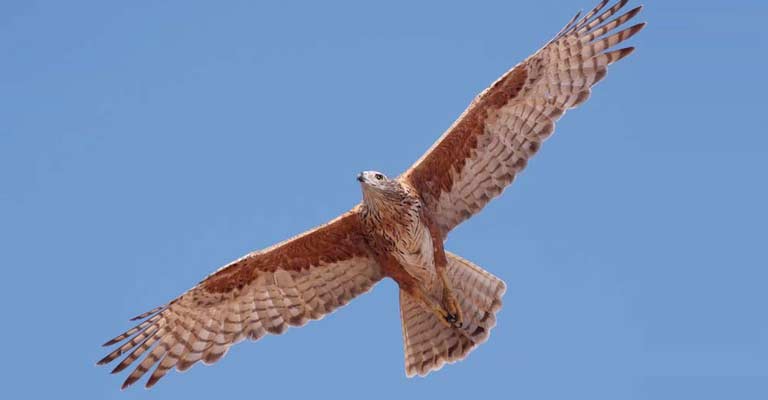
In flight, the Red Goshawk can be identified by its distinctive pattern. The wings are broad and rounded, and the bird often exhibits a slow and deliberate flapping style.
The chestnut-red upper wings and white underparts are visible in flight, aiding in identification.
Habitat and Range
The Red Goshawk is primarily found in the dense forests and woodlands of northern and eastern Australia, as well as in New Guinea and nearby islands.
Observing its habitat preferences, especially within the forest canopy, can provide additional clues for identification.
Behavior
This bird is known for its stealthy hunting behavior. It often perches inconspicuously in the treetops, waiting for prey to pass below.
Its hunting style involves sudden and swift attacks on small mammals, birds, and insects.
Vocalizations
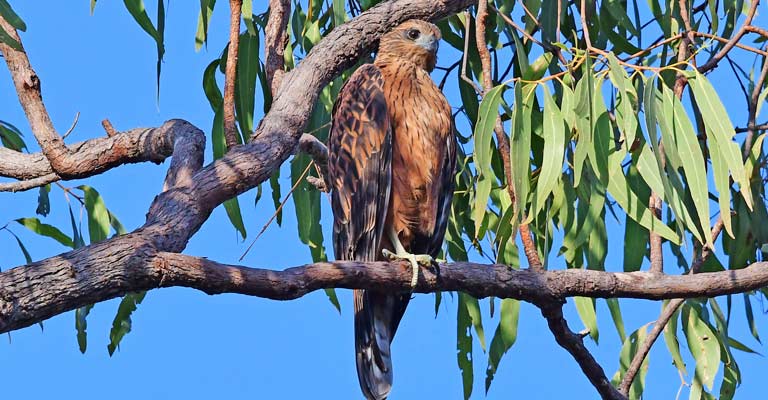
The Red Goshawk has a repertoire of distinctive calls. Its vocalizations include high-pitched whistles and sharp, melodious notes.
Learning these calls can be a valuable tool in identifying the presence of these raptors in a given area.
Conservation Status
Understanding the conservation status of the Red Goshawk is crucial for identification efforts. Classified as near-threatened, these birds face habitat loss and potential threats from human activities.
Conservation efforts may involve protecting their habitats and monitoring their populations.
Identifying the Red Goshawk involves a combination of visual cues, behavioral observations, and an understanding of its preferred habitat.
These majestic raptors contribute to the biodiversity of their ecosystems, making their identification and conservation important for the overall health of their respective environments.
Taxonomy of Red Goshawk
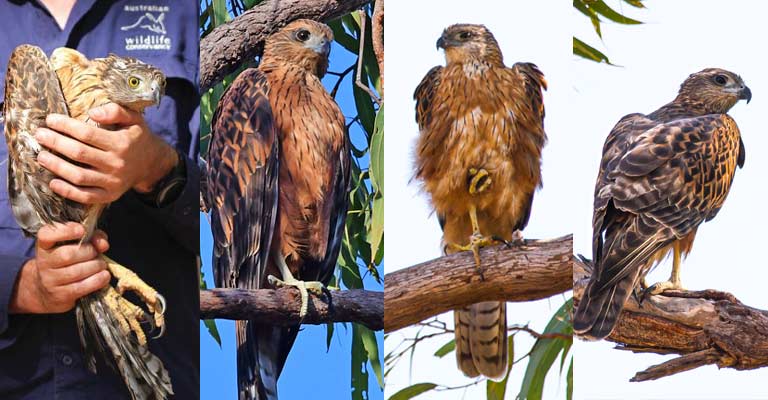
Here is a table outlining the taxonomical details of the Red Goshawk:
| Taxonomic Level | Classification |
| Domain | Eukaryota |
| Kingdom | Animalia |
| Phylum | Chordata |
| Class | Aves |
| Order | Accipitriformes |
| Family | Accipitridae |
| Genus | Erythrotriorchis |
| Species | E. radiatus |
The Red Goshawk (Erythrotriorchis radiatus) belongs to the Accipitridae family, characterized by diurnal birds of prey.
Specifically, it falls under the Accipitriformes order, which encompasses raptors such as hawks, eagles, kites, and Old World vultures.
Within the Accipitridae family, the Red Goshawk is part of the Accipitrinae subfamily, which includes various hawk and buzzard species.
Its genus, Erythrotriorchis, is unique, representing a small group of forest-dwelling raptors.
The Red Goshawk’s taxonomy reflects its evolutionary relationships and biological traits, offering insights into its place in the broader avian classification.
Evolutionary Life History of Red Goshawk
The Red Goshawk (Erythrotriorchis radiatus) is a captivating bird of prey, and understanding its evolutionary life history provides valuable insights into its survival strategies and ecological role.
This species has adapted over time to inhabit specific environments, develop unique nesting and breeding behaviors, and face challenges such as diseases and habitat loss.
Let’s delve into the evolutionary life history of the Red Goshawk, covering key aspects such as food, habitat, range, nesting, breeding, diseases, treatment, and conservation.
Food
Red Goshawks are carnivorous birds with a diverse diet. Their primary prey includes small to medium-sized mammals, birds, and insects.
Agile hunters, often rely on their powerful talons and sharp beaks to capture and consume their prey.
This species has evolved to adapt its hunting techniques based on the availability of different prey species in its environment.
Habitat
The evolutionary adaptation of the Red Goshawk is closely tied to its habitat preferences.
These birds are found in the dense forests and woodlands of northern and eastern Australia, New Guinea, and nearby islands.
Their choice of habitat reflects their need for suitable perches and hunting grounds, highlighting the importance of forest ecosystems to their survival.
Range Map
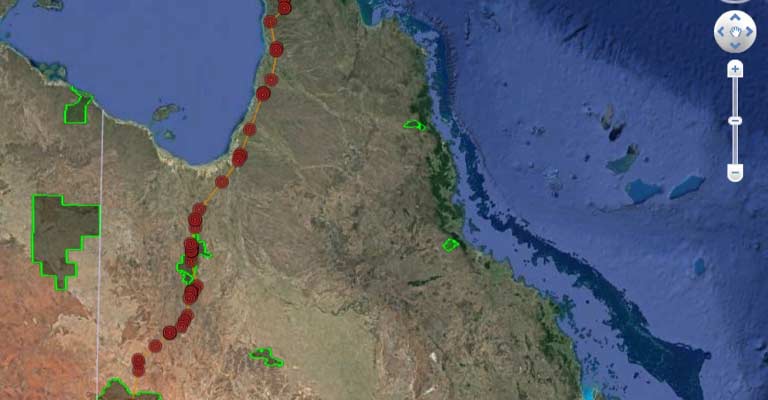
The Red Goshawk’s range is extensive, covering a broad expanse across Australia, New Guinea, and neighboring islands.
A detailed range map can help researchers and conservationists understand the distribution of the species, aiding in targeted conservation efforts to protect their habitats and populations.
Nesting
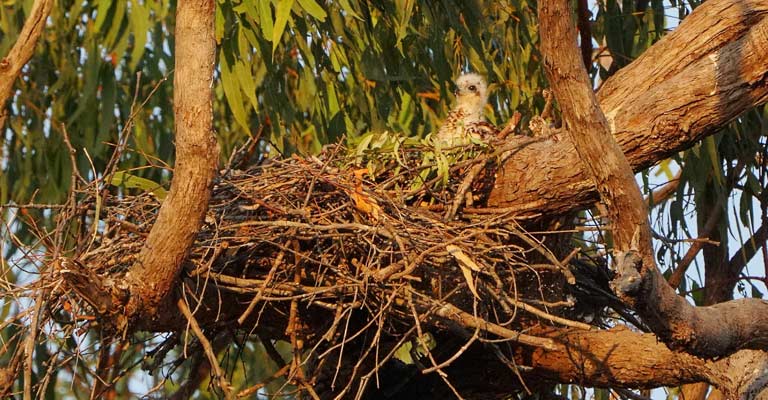
Red Goshawks are known for their elaborate nesting behaviors. They construct large nests high in the canopy using sticks and lined with softer materials.
The choice of nesting sites and the construction of robust nests are evolutionary strategies developed to protect their eggs and offspring from potential predators.
Here’s a table summarizing nesting details of the Red Goshawk:
| Nesting Details | Facts |
| Clutch Size | Typically 2 eggs, occasionally 1 or 3 |
| Number of Broods | Usually 1 per breeding season |
| Egg Length | Approximately 5.5 – 6.5 cm (2.2 – 2.6 inches) |
| Egg Width | Approximately 4 – 4.5 cm (1.6 – 1.8 inches) |
| Incubation Period | Around 35 days |
| Nestling Period | Approximately 40 – 45 days |
| Egg Description | Pale blue-green or white with sparse markings or blotches |
| Nest Construction | Large platform nest made of sticks, lined with softer materials |
| Nest Location | High in the canopy, often in large trees, providing a vantage point |
| Parental Roles | Both parents participate in the incubation and feeding of nestlings |
| Fledgling Independence | Young become independent after fledging, but parental care may continue for some time |
These nesting details provide insights into the reproductive biology and parental care behaviors of the Red Goshawk, crucial aspects for understanding and conserving this species.
Breeding
Breeding in Red Goshawks typically occurs during specific seasons, with pairs forming monogamous bonds.
The evolutionary aspect of their breeding behavior involves meticulous courtship displays, mate selection, and cooperative efforts in raising their young.
Understanding these breeding patterns is crucial for conservationists aiming to ensure the sustainability of the population.
Diseases
Like many species, Red Goshawks are susceptible to diseases that can impact their health and reproductive success.
Avian diseases, environmental pollutants, and habitat degradation can pose threats to their well-being.
Studying the evolutionary responses of these birds to diseases provides insights into their resilience and vulnerabilities.
Treatment
In cases where diseases affect Red Goshawk populations, conservationists may implement treatment strategies.
Veterinary care, habitat restoration, and monitoring programs are essential components of any comprehensive treatment plan aimed at maintaining the health and viability of the species.
Conservation
The conservation of Red Goshawks involves a multi-faceted approach. Understanding their evolutionary life history is integral to formulating effective conservation strategies.
Protecting their habitats, addressing human-induced threats, and implementing sustainable practices are vital steps in ensuring the long-term survival of this magnificent bird.
The evolutionary life history of the Red Goshawk is a fascinating narrative that unfolds across its food preferences, habitat selection, breeding behaviors, and responses to challenges.
Through a holistic understanding of these aspects, conservationists can work towards preserving this species and its role in maintaining the ecological balance of its native environments.
10 Fun Facts About Red Goshawk
The Red Goshawk (Erythrotriorchis radiatus) is a remarkable bird of prey with several intriguing characteristics. Here are 10 fun facts about the Red Goshawk:
- Vibrant Plumage: The Red Goshawk is aptly named for its striking chestnut-red plumage on its upperparts. This vibrant coloration sets it apart from other raptors and adds to its allure.
- Elusive Nature: Known for its elusive behavior, the Red Goshawk is often challenging to spot in the wild. It tends to inhabit dense forests and can skillfully blend into its surroundings, making sightings a special occurrence.
- Hunting Habits: These birds are skilled hunters, preying on a variety of small to medium-sized animals. Their hunting techniques include sudden aerial attacks and a reliance on powerful talons and beaks.
- Monogamous Pairs: Red Goshawks typically form monogamous pairs during the breeding season. The bond formed between mates involves intricate courtship displays, reinforcing the importance of pair cohesion.
- Unique Nest Construction: When it comes to nesting, Red Goshawks build large nests high in the forest canopy. Constructed with sticks and lined with softer materials, these nests showcase the species’ commitment to creating a secure environment for their offspring.
- Variable Clutch Size: While the usual clutch size consists of two eggs, Red Goshawks may occasionally lay one or three eggs. This variability in clutch size adds an interesting dynamic to their reproductive strategy.
- Impressive Egg Characteristics: The eggs of Red Goshawks are pale blue-green or white with sparse markings or blotches. These distinct characteristics contribute to the visual appeal of their nests.
- Parental Collaboration: Both male and female Red Goshawks actively participate in incubating the eggs and caring for the nestlings. This cooperative effort showcases the strong parental instincts of these birds.
- High Nesting Locations: Red Goshawks strategically choose elevated locations for their nests, often in large trees. This preference provides them with a strategic vantage point for hunting and keeping a watchful eye on their surroundings.
- Conservation Concerns: The Red Goshawk faces conservation challenges, including habitat loss and potential threats from human activities. As a near-threatened species, efforts to protect and preserve their habitats are crucial for their continued existence.
The Red Goshawk’s unique characteristics, from its vibrant plumage to its elusive nature and impressive nesting behaviors, contribute to its charm and significance in the avian world.
Understanding these fun facts sheds light on the importance of conservation efforts to ensure the continued survival of this captivating bird.
Wrapping Up
The Red Goshawk emerges as a fascinating avian species, characterized by its vibrant plumage, elusive nature, and intricate nesting behaviors.
From its unique hunting habits to the cooperative efforts of monogamous pairs in raising their young, every aspect of the Red Goshawk’s life history underscores its significance in the ecological tapestry.
However, the species faces challenges, emphasizing the importance of conservation to safeguard their habitats and ensure their continued existence.
As we delve into the evolutionary and behavioral nuances of this bird, a deeper appreciation for the delicate balance within ecosystems emerges, urging us to champion efforts that protect not just the Red Goshawk but the broader biodiversity of our natural world. Best of luck.